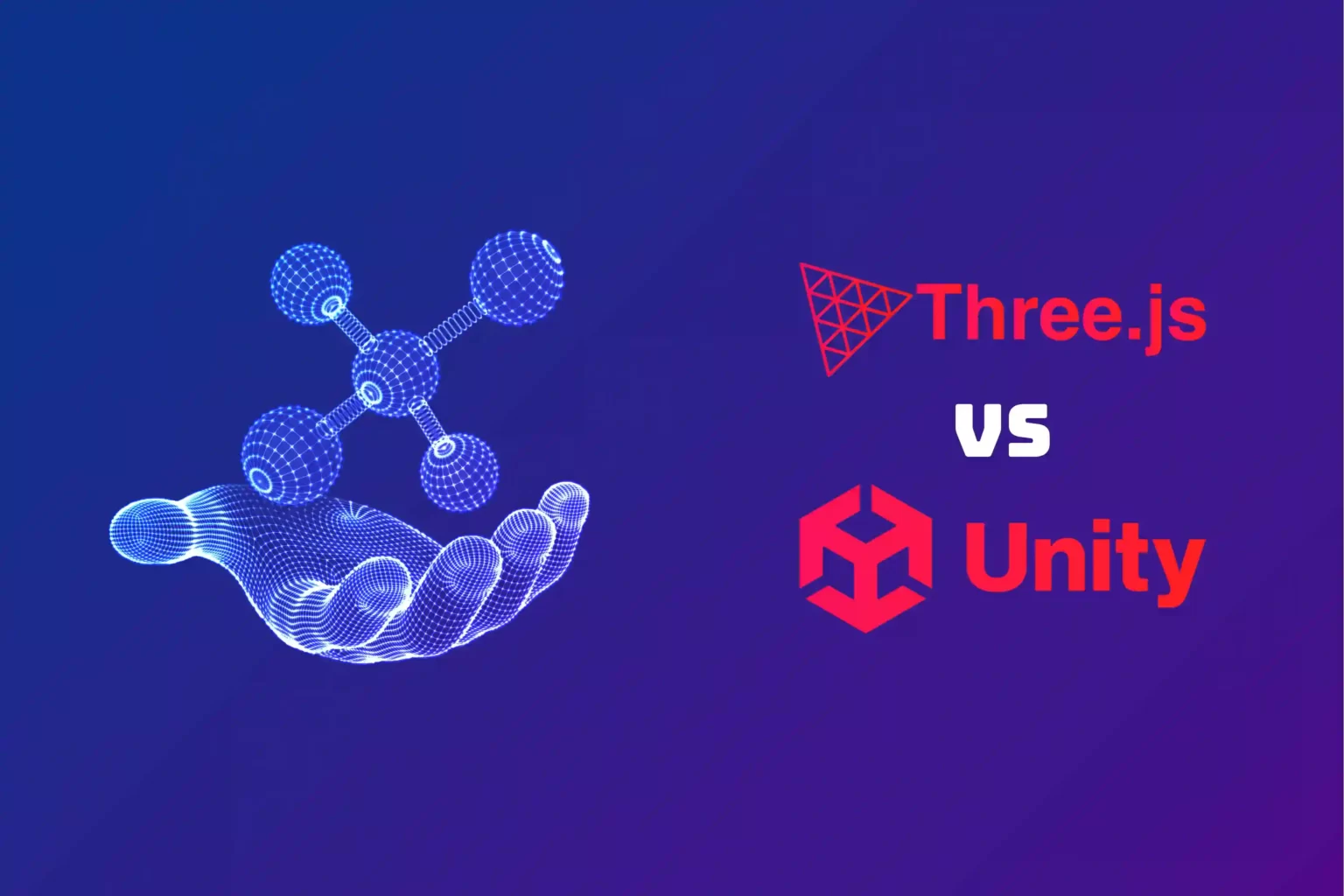Stepping into 3D development is akin to embarking on an enthralling quest. A crucial decision on this quest is picking the right tool for your project, a choice that can substantially steer the course, growth, and final triumph of your endeavor.In this exciting terrain, the spotlight falls on two tools Three.js and Unity.
Each of these is renowned for their unique features and the extensive opportunities they bring. So, let’s dive in and uncover the potential of these fascinating tools in your 3D development journey.
Understanding the Three.js & Unity Frameworks
Three.js and Unity are powerful tools in 3D graphics and game development. Three.js creates excellent web-based 3D graphics, while Unity shines in developing unique 2D and 3D gaming user experiences.
Three.js Framework
Three.js brings 3D graphics & animations to life with relative ease. It’s a lightweight, feature-packed framework perfect for developers aiming for seamless browser compatibility. Its attributes shine through its ability to produce interactive visualizations and animations using WebGL without breaking a sweat. Three.js simplifies the complexity of 3D development, making it an attractive choice for many.
Unity Framework
Unity, a seasoned veteran in game development, boasts impressive features and unmatched versatility. This powerful engine excels in crafting visually stunning games, virtual reality experiences, and interactive simulations. Unity’s strength lies in its ability to handle complex graphics, and extensive ecosystem, providing an array of assets and resources for developers to exploit.
Performance and Scalability
Performance and scalability ensure your 3D project runs smoothly and can grow without limitations. Superior performance provides a seamless user experience, while scalability accommodates complexity and growth over time.
Performance
In the performance arena, both Three.js and Unity bring their A-game. Three.js impresses with its speedy rendering within web browsers, while Unity astounds with its ability to manage high-quality visuals and physics simulations. Regarding 3D development, performance is indispensable in ensuring smooth, realistic experiences.
Scalability
As for scalability, both Three.js and Unity prove competent. Three.js handles scaling within browser environments admirably, while Unity, with its robust architecture, can effortlessly manage large-scale, complex 3D projects. Scalability is crucial when dealing with growth and complexity in 3D development.
Ease of Use and Versatility
Ease of use and versatility are crucial for effective 3D development. Three.js offers a straightforward interface for web development, while Unity brings versatility for creating diverse gaming experiences.
Ease of Use
Three.js and Unity cater to developers’ needs with their user-friendly interfaces and intuitive development workflows. Three.js simplifies WebGL programming, making it easy for developers to dive into 3D, while Unity’s well-documented platform, along with its design-friendly interface, makes development a breeze. Ease of use can dramatically enhance developer productivity and efficiency.
Versatility
Versatility is yet another area where both frameworks shine. Three.js, with its flexible JavaScript base, allows a broad range of functionalities, from creating simple animations to complex interactive scenes. On the other hand, Unity provides an extensive toolkit and flexibility that can cater to many 3D development requirements. A versatile framework fosters creativity and allows for the developing of varied and unique 3D experiences.
Graphics Rendering and Animation Capabilities
Graphics rendering and animation capabilities define the visual appeal of your 3D project. Three.js is efficient for web graphics, while Unity offers high-end rendering and dynamic animations.
Graphics Rendering
While Three.js and Unity offer robust graphics rendering capabilities, their specialties vary. Three.js is renowned for its efficient rendering in a web context, making it an excellent tool for browser-based applications. Conversely, Unity shines in gaming graphics, offering high-end rendering capabilities suitable for creating visually striking games. High-quality visuals are undeniably pivotal in making 3D projects visually appealing and engaging.
Animation Capabilities
Three.js offers a robust animation system, perfect for crafting detailed, interactive animations within a web environment. Unity outdoes itself with a comprehensive animation suite with a built-in animator for creating complex, dynamic sequences. Good animation capabilities are the lifeblood of any 3D scene, turning static models into living, breathing entities.
Cross-platform Compatibility
Regarding cross-platform compatibility, both Three.js and Unity have their strengths. Three.js caters to all modern browsers, so it is easy to reach a broad audience on the web. In contrast, Unity supports many platforms, including mobile, desktop, and VR, expanding its reach significantly. The ability to develop for multiple platforms can drastically increase your project’s potential audience and impact.
Development Workflow and Community Support
Development workflow and community support can influence a project’s success. Three.js provides a streamlined JavaScript workflow, while Unity boasts extensive tools and a vibrant, supportive community.
Development Workflow
The development process and tools in Three.js and Unity are distinct yet efficient in their ways. Three.js offers a simplified workflow for developers comfortable with JavaScript, while Unity’s intuitive UI and extensive toolkit facilitate a smooth development journey. A streamlined workflow is pivotal for efficient development, reducing overhead and allowing for a faster turnaround.
Community Support
Three.js and Unity both boast thriving developer communities. Three.js has a dedicated, collaborative community that thrives on open-source contributions. Unity’s community, on the other hand, is massive and active, offering extensive documentation, tutorials, and assets. A thriving community can be a significant advantage, providing learning resources, collaboration opportunities, and troubleshooting assistance.
Learning Curve
The learning curves for Three.js and Unity differ, given their varied focuses. Three.js may prove easier for developers familiar with JavaScript, while Unity’s learning curve may be steeper but is well-supported by a wealth of learning resources. Considering learning resources and documentation is vital for smooth skill acquisition and problem-solving.
Conclusion
In exploring Three.js and Unity, we’ve delved into their respective features, strengths, and trade-offs. Both frameworks have impressive capabilities, but choosing between them depends on your needs and goals.
Three.js excels in creating browser-based 3D graphics, while Unity shines in gaming and multi-platform applications. Considering the project requirements, your familiarity with the languages, tools, and learning resources is critical.
Ultimately, both Three.js and Unity serve as robust, reliable frameworks in 3D development. Choosing the right one can propel your project from conception to remarkable execution. It’s about finding the perfect fit for your creative vision.



